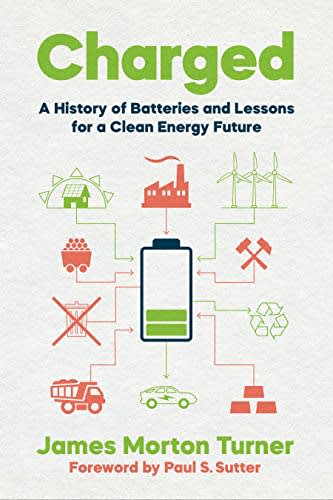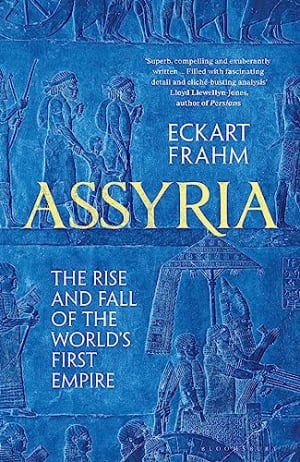The history of an electric car battery begins with one of the biggest mass extinction events in the history of the plant. I’m talking of course about the Permian-Triassic mass extinction 250 million years ago, in which 95% of all species - and therefore probably 99.9% of all individual lifeforms1 - died. The cause is thought to be a devastating volcanic eruption in what is now Siberia which lasted for millions of years and spewed out so much sulphur dioxide and carbon dioxide that the earth became almost uninhabitable. In many places the largest surviving animal was the mollusc.
But on the positive side the huge magma superplume that was the cause of all this trouble also churned up colossal gobbets of metal rich molten rock. This mineralised magma infused the earth’s crust at the eruption sites to make that part of Russia highly productive mining territory and a key source of nickel.
James Morton Turner in Charged: A History of Batteries and Lessons for a Clean Energy Future explains that Nickel is not the only ingredient required for your car battery but it is often a much more significant component than the lithium that we normally associate with electric cars, as you can see from the emoji-chart below:
What goes into a Nickel-Cobalt-aluminium car battery pack?
🔋🔋🔋🔋🔋🔋🔋🔋 ← Graphite (71 kg)
🔋🔋🔋🔋🔋 ← Nickel (44 kg)
🔋 ← Cobalt (8 kg)
🔋 ← Lithium (7 kg)
🔋🔋🔋🔋🔋🔋🔋🔋🔋🔋🔋🔋🔋🔋🔋🔋🔋 ← Other (157 kg)
This long cooled nickel rich super-plume was first mined in Russia in the early 20th century, with a workforce of tens of thousands of prison labourers, exiled there during Stalin’s purges, and based in the Siberian town of Norilsk.
In the 1950s the gulags were closed and the workers were paid higher salaries to incentivise them to stay in this remote wintry location. In the 1970s a large smelting plant opened making Norilsk the leading site of nickel production in the world.
Impact assessment
By the early 2000s the area was in a pretty bad way. In the middle of nowhere, belonging to a government that didn’t typically prioritise the natural environment, and using highly polluting processing methods, it was considered one of the top ten worst-polluted sites in the world.
Acid deposition had scorched two thousand square miles of surrounding forests. Air and water sampling revealed pollution levels exceeding Russian standards by more than an order of magnitude. Life expectancies for Norilsk employees were ten years below the Russian average
Charged, James Morton Turner
After this point there was an intensive effort to clean up production, but problems and bad publicity have remained.
All of which is to say that the materials that go into our batteries often have a chequered past, but if we are to realise a green energy revolution we will need much more of them, and we should be aware of the non-financial cost that we - or more likely someone else living in industrial mining area - may pay.
A compromised environmentalist
This history of nickel was also a bit of a revelation for me in understanding some of the antics of Elon Musk. As the CEO of Tesla, an electric car company reliant on nickel, lithium and other globally sourced materials, he may be more helpfully viewed not as an irresponsible eccentric, but instead as a bellwether for the compromises that all environmentalists face.
So when Musk offers his opinions on Taiwanese politics or the Russian Ukraine war, surely that is only because he wants access to the raw materials that are extracted and processed in Russia and China. Why does he want these materials? To power the green energy revolution that will save the planet (and make him rich).
What’s in the book?
Charged takes us through the history of batteries over the last hundred years or so, starting with the lead-acid batteries that are ubiquitous in our petrol powered cars, to the AAs that feed our kids toys, the Lithium-Ion batteries that feed our own toys / mobile phones, before finishing with an in-depth look at car batteries - and the benefits and necessary compromises of a green energy revolution.
He ends with four policy recommendations, which I have copied below in case you are busy politician with no time to real a whole book, but hidden behind a drop down in case you love reading books and hate to have the ending spoiled:
Four policy recommendations from James Morton Taylor in Charged
(click for dropdown)
1. Leverage government leadership to build a clean energy future from the ground up.
2. Promote policies to ensure responsible production and sourcing of minerals for a clean energy future.
3. Support new and expanded mining and refining operations in the United States.
4. Stop trying to recycle our way to a clean energy future.
Getting the message across
Although the subject of the book is urgent, the style is calm and factual, with Turner explaining the science behind the different battery technologies in clear layman’s terms, setting out the economic history, and the past and current social impact.
For example when talking about Lithium-Ion batteries he develops a nice bookshelf analogy to help us understand how electrons are checked out (when the batteries are being used) and checked back in (when the batteries are being recharged).
He then covers lithium production and its migration to the great “salars”, the high altitude salt plains of South America. These are the salty remnants of ancient seas now thrust upwards to an altitude of more than 3,000 metres. As the seas evaporated they left behind salt but also subsurface water. Because it pretty much never rains up there, this groundwater is a kind of sea-water concentrate and contains 0.2% to 0.4% lithium - enough to make it commercially viable to extract.
This “lithium water” can be pumped up and concentrated further in huge open-air evaporation pools.2
Salar salaries
Turner then discusses the impact that these colossally sized manufacturing facilities have had on the people that live nearby, changing their communities from those focused on grazing, farming and salt collection, to jobs connected with mineral production, or secondary jobs nearby.
The environmental impact is also considered - what is the effect of pumping out all of this groundwater on the supply of freshwater, or wildlife populations? At the moment this seems an open question.
Keep it coming
Perhaps the key message of the book is that we will need minerals like lithium to enable our transition to a green energy world, and this will innevitably require new mining and refining. If the number of batteries in the world is to increase it is clear that recycling just the old batteries will never supply enough materials even if recycling is 100% efficient which it is not.
The next message, close on the heels of the first, is that the history of companies (i.e. humans) in the battery industry shows that they can’t be relied upon to automatically “do the right thing” for the environment and society, in addition to selling batteries, without transparency and appropriate regulations and incentives.
A balanced assessment
One thing I really appreciated about Charged is the author’s attention to both sides of the green energy debate. He is not out to just name and shame, but instead give us readers enough information to form a judgement ourselves.
For example while Turner wants to make sure we are aware of the potential impact of the battery industry, he also provides the context that this industry is still relatively small on a global scale: the total mass of lithium-ion batteries manufactured in 2010 was about 5 million tonnes; the steel industry manufactured 1.4 billion tonnes of steel in the same year, 280 times this amount.3
A call to action
I also found it to be a quietly inspiring book. One small example of this is that after finishing it I have been trying to get my kids more into battery technology and spent last Saturday morning attempting to manufacture a potato battery. Although admittedly we only managed to get a brief flicker of light from our little red LED. I should also acknowledge that my kids gave up on me and wandered off half-way through the experiment while I desperately added ever more potatoes. But you’ve got to start somewhere.
Any downsides?
Charged covers broad topics with just sufficient depth to get the point across: weighing in at 185 pages it has an impressively high “thoughts per gallon” ratio. The flip side of this is that passages are descriptive and in the third person, rather than using the more (long winded) journalistic technique of introducing colourful characters and getting them to tell the story for you. I found the “direct info download” approach refreshing, and the prose crisp and precise, but others may find it dry.
The other thing to be aware of is that this is a book written with people living in the United States in mind. So the history here is the US experience, and the focus for the future is what the US government should be doing. The issues are however sufficiently global to make this a fairly minor consideration for non-US residents such as myself from the UK.
Conclusion
Batteries are indispensable to a greener future - and Charged gives us a pretty in-depth but also accessible overview. It is not a high voltage text but it nevertheless contains a powerful message for how we navigate to a more sustainable world.
I made up the 99.9% but I feel like it must be about right. Although this is probably the wrong way to look at it as the extinctions of species occurred on a timeframe of tens of thousands to millions of years, so it may be as much about having fewer children as popping clogs. ↩︎
Perhaps like me you have come across these gigantic and often colourful man-made features before when idly browsing google maps satellite view, and not known what they were. I was fascinated to discover that they are basically your iPhone diluted 1.9 million times - or at least the 1g of lithium in your iPhone battery! If you want to take a look yourself here is the satellite view of the Chilean lithium production site on google maps, with an emerald green final processing site closer to the coast. ↩︎
Here is a graphical representation of that ratio of 5 million tonnes of lithium-ion batteries produced to 1.4 billion tonnes steel produced (a ratio of 280:1) 🔋🔧🔧🔧🔧🔧🔧🔧🔧🔧🔧🔧🔧🔧🔧🔧🔧🔧🔧🔧🔧🔧🔧🔧🔧🔧🔧🔧🔧🔧🔧🔧🔧🔧🔧🔧🔧🔧🔧🔧🔧🔧🔧🔧🔧🔧🔧🔧🔧🔧🔧🔧🔧🔧🔧🔧🔧🔧🔧🔧🔧🔧🔧🔧🔧🔧🔧🔧🔧🔧🔧🔧🔧🔧🔧🔧🔧🔧🔧🔧🔧🔧🔧🔧🔧🔧🔧🔧🔧🔧🔧🔧🔧🔧🔧🔧🔧🔧🔧🔧🔧🔧🔧🔧🔧🔧🔧🔧🔧🔧🔧🔧🔧🔧🔧🔧🔧🔧🔧🔧🔧🔧🔧🔧🔧🔧🔧🔧🔧🔧🔧🔧🔧🔧🔧🔧🔧🔧🔧🔧🔧🔧🔧🔧🔧🔧🔧🔧🔧🔧🔧🔧🔧🔧🔧🔧🔧🔧🔧🔧🔧🔧🔧🔧🔧🔧🔧🔧🔧🔧🔧🔧🔧🔧🔧🔧🔧🔧🔧🔧🔧🔧🔧🔧🔧🔧🔧🔧🔧🔧🔧🔧🔧🔧🔧🔧🔧🔧🔧🔧🔧🔧🔧🔧🔧🔧🔧🔧🔧🔧🔧🔧🔧🔧🔧🔧🔧🔧🔧🔧🔧🔧🔧🔧🔧🔧🔧🔧🔧🔧🔧🔧🔧🔧🔧🔧🔧🔧🔧🔧🔧🔧🔧🔧🔧🔧🔧🔧🔧🔧🔧🔧🔧🔧🔧🔧🔧🔧🔧🔧🔧🔧🔧🔧🔧🔧🔧🔧🔧🔧🔧🔧🔧🔧🔧🔧🔧🔧🔧🔧🔧 ↩︎
Book details
(back to top)- Title -
Charged : A History of Batteries and Lessons for a Clean Energy Future
- Author -
James Morton Turner
- Publication date -
August 2022
- Publisher -
University of Washington Press
- Pages -
185
- ISBN 13 -
9780295750248
- Podcast episode -
Something You Should Know: How Batteries Changed the World & Why Status and Culture Matter
- Amazon UK -
- Amazon US -



